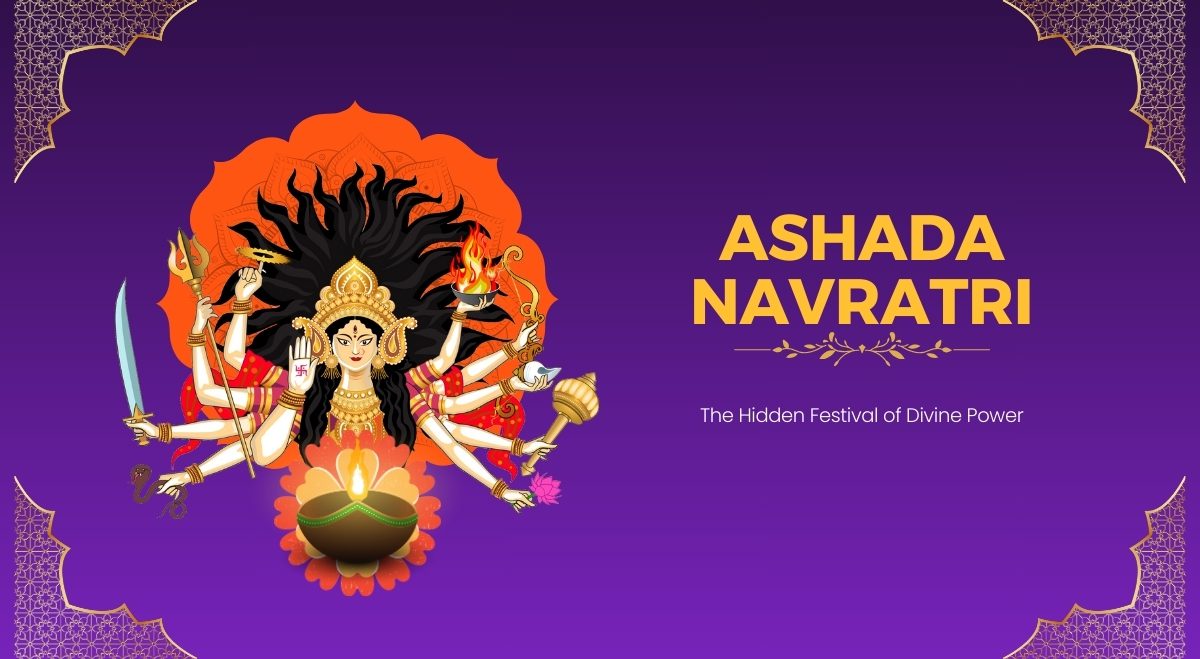Ashada Navratri, also known as Gupt Navratri or Varahi Navratri, is a nine-day festival dedicated to worshipping the divine feminine energy in Hinduism. This lesser-known Navratri holds immense spiritual significance for devotees, particularly those engaged in Tantric practices and Shakti worship.
Dates for Ashada Navratri 2025
In 2025, Ashada Navratri will begin on June 26 and conclude on July 4. The auspicious timings for the festival are as follows:
- Pratipada Tithi Begins: 4:26 AM, June 26, 2025
- Pratipada Tithi Ends: 4:26 AM, June 27, 2025
- Ghatsthapana Muhurat: 5:28 AM to 10:06 AM, June 26, 2025
Significance of Ashada Navratri
Ashada Navratri is considered one of the two “Gupt” or secret Navratris, occurring during the Shukla Paksha (waxing phase of the moon) in the Hindu month of Ashada. This festival is particularly important for worshippers of Goddess Varahi, one of the seven Matrikas mentioned in Devi Mahatmya.
The festival’s timing during the monsoon season holds special significance. By observing fasts and maintaining a disciplined lifestyle during these nine days, devotees believe they can better adapt to changing weather conditions and reduce the risk of seasonal illnesses.
Legends Associated with Ashada Navratri
One of the most popular legends associated with Ashada Navratri involves Rishi Shrungi. According to this tale, a woman approached the sage seeking help to overcome her husband’s immoral behavior. Rishi Shrungi advised her to perform Gupt Navratri, explaining that it was a secret form of worship that could bring about positive changes in one’s life.
The woman followed the sage’s advice, and through her intense devotion during Gupt Navratri, she received the blessings of Goddess Durga. As a result, her husband abandoned his wayward lifestyle and became a responsible family man
Deities Worshipped During Ashada Navratri
During Ashada Navratri, devotees primarily worship the nine forms of Goddess Durga, known as Navadurga. Additionally, this festival is closely associated with the worship of the Ten Mahavidyas, powerful manifestations of the divine feminine energy in Tantric traditions. The Ten Mahavidyas include:
- Kali – The one who swallows time
- Tara – The protector
- Tripura Sundari – The most beautiful in the three worlds
- Bhuvaneshwari – The Goddess of the world
- Bhairavi – The fiercest one
- Chinnamasta – The one who cut her own head
- Dhumvati – The elderly one or widow
- Bagalamukhi – The one who numbs the enemy
- Matangi – The Goddess of music and speech
- Kamalatmika – The graceful one
Rituals and Practices
The rituals observed during Ashada Navratri are primarily focused on enhancing the power of tantra and sadhana (spiritual practices). Some key practices include:
- Kalash Sthapana: An auspicious pot or ‘kalash’ is set up to honor Goddess Aadhya Shakti.
- Fasting: Many devotees observe strict fasts throughout the nine days.
- Puja and Meditation: Elaborate pujas are performed to please the Goddess and seek her blessings.
- Recitation of Sacred Texts: Devotees often recite the Devi Path and Durga Saptashati.
- Worship of Young Girls: Performing puja of young girls during this period is considered meritorious.
Regional Variations in Celebration
While Ashada Navratri is observed across India, it has some regional variations:
- In Vijayawada, it’s celebrated as Shakambari Utsavam at the Kanakadurga temple.
- In Himachal Pradesh, it’s referred to as Guhya Navratri.
- In Tamil Nadu, Kerala, and parts of Karnataka and Andhra Pradesh, it’s celebrated as Varahi Navratri.
Comparison with Other Navratri Festivals
Ashada Navratri differs from the more widely celebrated Chaitra and Sharada Navratris in several ways:
- Timing: It occurs during the monsoon season, unlike the spring and autumn celebrations.
- Focus: There’s a stronger emphasis on Tantric practices and worship of the Mahavidyas.
- Popularity: It’s less widely known and celebrated, hence the name “Gupt” or secret Navratri.
Spiritual Benefits of Observing Ashada Navratri
Devotees believe that observing Ashada Navratri can bring numerous spiritual and material benefits:
- Spiritual Cleansing: Fasting and rituals are believed to purify the mind and body.
- Divine Blessings: Sincere worship is thought to attract the blessings of Goddess Durga.
- Enhanced Willpower: The discipline of fasting can strengthen one’s resolve and self-control.
- Positive Energy: Participating in rituals and maintaining a sattvic diet is believed to generate positive energy.
- Fulfilment of Desires: Tantric practitioners believe that worshipping the Mahavidyas during this time can help fulfill specific desires.
In conclusion, Ashada Navratri offers a unique opportunity for spiritual growth and divine connection. While it may not be as widely celebrated as other Navratris, its focus on Tantric practices and the worship of powerful feminine energies makes it a deeply significant festival for many devotees. As we approach Ashada Navratri 2025, consider exploring this hidden gem of Hindu spirituality and experiencing its transformative power firsthand.

